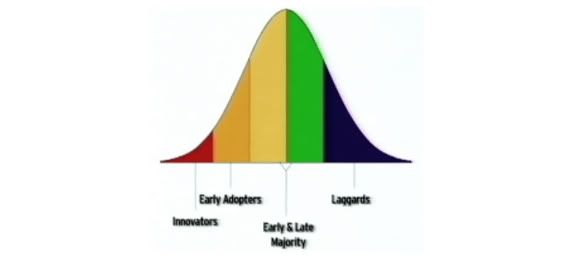
Look! It's a pink cow! Scroll down to read this text in English.
A exposição de Seth Godin no TED (via Staffan Estberg) é um excelente ponto de partida para reflexão acerca do que capta a atenção do público. Seth é hilariante e apresenta algumas ideias provocadoras sobre o que torna algo “notável”. A metáfora da vaca cor-de-rosa, no entanto, levanta algumas questões sérias quando se começa a falar de arquitectura – como ele faz – e de blogging. Aqui ficam as minhas opiniões.

Seth afirma que quase sempre os “marketers” tentaram captar a atenção da grande maioria, aquele grupo no centro do gráfico. Explica ainda que isso é um erro porque estes são os indivíduos que são bons a ignorar coisas. E tem razão. Assim a coisa certa a fazer é captar a atenção dos “inovadores” e dos “early adopters”, os tipos que são obcecados com qualquer coisa, os que se entusiasmam o suficiente para fazer passar a mensagem.
Fico assim a pensar se não existe aqui uma contradição. Porque estes tipos no princípio do gráfico não são necessariamente aqueles que se interessam por vacas cor-de-rosa. Claro que todos paramos para olhar para uma vaca cor-de-rosa de vez em quando. Mas ao fim de algum tempo isso torna-se um velho truque. O mecanismo da novidade torna-se tão entediante como tudo o resto na corrente das coisas. Ainda nos importamos com “o edifício mais alto do mundo”? Temos devaneios por uma “torre que roda”? A coisa ainda não está construída e eu já estou a bocejar.
Assim, para chamar a atenção destes tipos talvez seja preciso algo mais que uma vaca cor-de-rosa. De facto, não precisamos de nenhuma. O que é importante é explicar a vaca, contextualizá-la, e fazê-los pensar “ei, eu não sabia que as vacas faziam isto”. É aí que entram os blogs. Porque um blogger interessante é alguém que oferece perspectiva e contexto. O caminho para o sucesso está na singularidade e espessura, que é afinal o que este grupo de gente obcecada anda à procura. Pode levar algum tempo, mas se forem bons a fazer isso, eles acabarão por vir ver o que vocês andam a fazer.
Já escrevo um blog há alguns anos e tenho aprendido alguns truques pelo caminho. Digamos que publico um conjunto de novas imagens de um edifício recente de um arquitecto famoso. É uma aposta segura e posso nomear uns quantos blogs que certamente me vão “linkar”. E assim ganharei umas centenas de visitas. Mas digamos que publico um trabalho completamente surpreendente e inovador de um arquitecto que vocês praticamente nunca ouviram falar. Estou certo que os bloggers do costume não me dedicarão um “link”. Mas os tipos que andam a pensar fora da caixa podem ficar entusiasmados, comentar, “linkar”, partilhar. No processo, vão descobrir-se a ficar mais ligados à rede.
De certa forma, a visibilidade na rede é como um mercado de valores e a moeda é credibilidade. Não é algo que se construa num só dia, mas pode ser feito e está aberto a qualquer um que esteja ligado a um cérebro. É por isso que não compreendo certos bloggers que dizem em voz alta que não se importam com o número de visitantes que recebem. É uma atitude respeitável quando se está focado em manter uma qualidade e estilo específico de blogging, independentemente da sua popularidade. Mas quando não se tem qualidade nem visibilidade, claro que não se podem gabar de visitantes que não existem.
Manter a qualidade e ser específico é exactamente o que torna um blog bem sucedido. Um olhar rápido por alguns dos mais populares blogs de arquitectura demonstra isso mesmo. E ser popular, ou como diz Seth Godin, notável, é importante porque é a medida da nossa capacidade de expandir para dentro da rede, através dos visitantes individuais, dos blogs que nos “linkam” e dos leitores de “feeds”.
Aquilo que de melhor têm os blogs é a sua capacidade de atrair um tipo de leitor específico. Podem descobrir que é impossível falar para a grande maioria, mas vão ver que é possível criar o vosso nicho de interesse, atraindo pessoas que se interessam pelas coisas que tanto vos apaixonam.
Por isso, vamos lá olhar bem para a vaca, não acham?
Seth Godin's presentation on TED (via Staffan Estberg) is a great starting point for reflection on what grasps people’s attention. The guy is hilarious and presents some startling ideas on what makes things “remarkable”. The pink cow metaphor, however, raises some serious thoughts when you address the issue of architecture – which he does – and even blogging. Here’s my two cents about it.
Read More »
Seth explains that for a long time marketers have been targeting the “early and late majority”, that’s the big group in the center of the graphic. He says that’s a big mistake because those are the guys that are good at ignoring stuff. He’s right. So the right thing to do is to seize the attention of the “innovators” and “early adopters”, those are the guys that are obsessed with something, the ones that get engaged enough to spread the word around.
So I’m wondering if this isn’t a bit of a contradiction. Because these folks at the beginning of the graphic aren’t necessarily the ones that care about pink cows. Now everyone stops to stare at a pink cow now and then. But after a while it becomes just a gimmick. The novelty device becomes as boring as everything else in the stream of things. Do you still care about “the tallest building in the world”? Fancy for a “rotating tower”? The thing isn’t built yet and I’m already yawning.
So if you want to target these guys maybe you have to show them more than a pink cow. In fact, you don’t need a pink cow. You need to explain the cow, contextualize it, and make them think “hey, I didn’t now cows did that”. That’s were blogs come in. Because an interesting blogger is someone who provides perspective and context. The path to success is specificity and depth, and that’s what this specific group of obsessed people is looking for. It may take some time, but if you’re good at it, they will come to see what you’re up to.
Now I’ve been blogging for a few years and I’ve learned some tricks in the process. Let’s say I publish a brand new set of images of the latest building by a famous architect. It’s a safe bet and I could name a few blogs that I’m sure are going to link to it. And I’ll get a few extra hundred readers from it.
But say I publish a completely unusual outstanding piece of work by an architect that you’ve probably never heard of. I’m sure I won’t get one link from the guys that play it safe. But the guys that are thinking outside the box will become engaged, comment, link and share. In the process, you’ll find yourself becoming more established on the web.
In a way, visibility on the web is a bit like a stock market and the currency is credibility. It’s not something you build in a day, but it can be done and it’s open to everybody with a brain attached.
That’s where I don’t get some bloggers who say out loud they don’t care about how many visitors they get. It’s a respectable attitude when you’re focused on maintaining a specific style and quality of blogging independently of its popularity. But when you have no quality and no visibility, of course you don’t brag about visitors.
Maintaining quality while being specific is exactly what makes blogs successful. One fast look at some of the most popular architecture blogs around shows just that. And being popular, or as Seth Goodin says, remarkable, is important because it will measure your ability to expand into the web, through individual visitors, linking blogs and feed readers.
The greatest thing about blogs is that they attract a specific kind of reader. You may find yourself unable to reach out to the big majority, but you’ll see that it’s possible to create your niche of interest, attracting people that care about the things you’re passionate about just as much as you.
So let’s take a good look at that cow, shall we?
So I’m wondering if this isn’t a bit of a contradiction. Because these folks at the beginning of the graphic aren’t necessarily the ones that care about pink cows. Now everyone stops to stare at a pink cow now and then. But after a while it becomes just a gimmick. The novelty device becomes as boring as everything else in the stream of things. Do you still care about “the tallest building in the world”? Fancy for a “rotating tower”? The thing isn’t built yet and I’m already yawning.
So if you want to target these guys maybe you have to show them more than a pink cow. In fact, you don’t need a pink cow. You need to explain the cow, contextualize it, and make them think “hey, I didn’t now cows did that”. That’s were blogs come in. Because an interesting blogger is someone who provides perspective and context. The path to success is specificity and depth, and that’s what this specific group of obsessed people is looking for. It may take some time, but if you’re good at it, they will come to see what you’re up to.
Now I’ve been blogging for a few years and I’ve learned some tricks in the process. Let’s say I publish a brand new set of images of the latest building by a famous architect. It’s a safe bet and I could name a few blogs that I’m sure are going to link to it. And I’ll get a few extra hundred readers from it.
But say I publish a completely unusual outstanding piece of work by an architect that you’ve probably never heard of. I’m sure I won’t get one link from the guys that play it safe. But the guys that are thinking outside the box will become engaged, comment, link and share. In the process, you’ll find yourself becoming more established on the web.
In a way, visibility on the web is a bit like a stock market and the currency is credibility. It’s not something you build in a day, but it can be done and it’s open to everybody with a brain attached.
That’s where I don’t get some bloggers who say out loud they don’t care about how many visitors they get. It’s a respectable attitude when you’re focused on maintaining a specific style and quality of blogging independently of its popularity. But when you have no quality and no visibility, of course you don’t brag about visitors.
Maintaining quality while being specific is exactly what makes blogs successful. One fast look at some of the most popular architecture blogs around shows just that. And being popular, or as Seth Goodin says, remarkable, is important because it will measure your ability to expand into the web, through individual visitors, linking blogs and feed readers.
The greatest thing about blogs is that they attract a specific kind of reader. You may find yourself unable to reach out to the big majority, but you’ll see that it’s possible to create your niche of interest, attracting people that care about the things you’re passionate about just as much as you.
So let’s take a good look at that cow, shall we?
![[a barriga de um arquitecto]](https://blogger.googleusercontent.com/img/b/R29vZ2xl/AVvXsEh4jxSFgS7aN5np9gNAv5D6FLs8GihH_1lu1XrTdi7CmZ6DwtdH1DQ7u6RQnN6SosH_HFrY3YQzoLlvzBeEK-cxh0dveIqPEsEC661K_iPUh0NifbNNN-mRoy6nVc0ycEi972Llyg/s1600/bA_LOGO_MOCHA_2016_650.jpg)

Muito incentivador e generoso o teu texto.
ResponderEliminarO link do Seth's Blog também foi de grande utilidade :)
Saudações.
muito interessante.
ResponderEliminaruma vaca cor-de-rosa pode fazer-me olhar mas o q faz com q 5mn depois eu n me tenha esquecido dela é se eu estiver interessada em vacas e gostar da perspectiva cor-de-rosa!
ou seja só volto a um blog ou só sigo os links de um blog se me disserem algo e n tem q ser algo q eu já saiba mas algo q capte a minha atenção e esteja próximo da minha esfera de interesses.
para um blogger genérico é um mundo sem limites e extremamente disperso, por isso qq procura de sucesso implica encontrar o seu nicho, encontrar os seus otaku (han, sempre o japão), coisa q tu no ba tens procurado fazer.
de qq maneira n acredito que algo funcione se uma pessoa não falar daquilo que mais lhe interessa, daquilo que a apaixona, de outro modo qq coisa soará falsa. a tal credibilidade de q falas.
o número de visitantes conta e muito. por exemplo o teu blogue q q acompanho há anos tem mudado muito com o aumento exponencial de visitas, tem largado o discurso mais pessoal mas ser mais um espaço de reflexão sobre temas específicos.
mas já agora: n interessa muito quão interessante e fantástico é um blog se ninguém o lê, se ninguém fala dele, certo? quais são então os limites para a publicidade de um blog?
Gosto de te ler!
ResponderEliminar